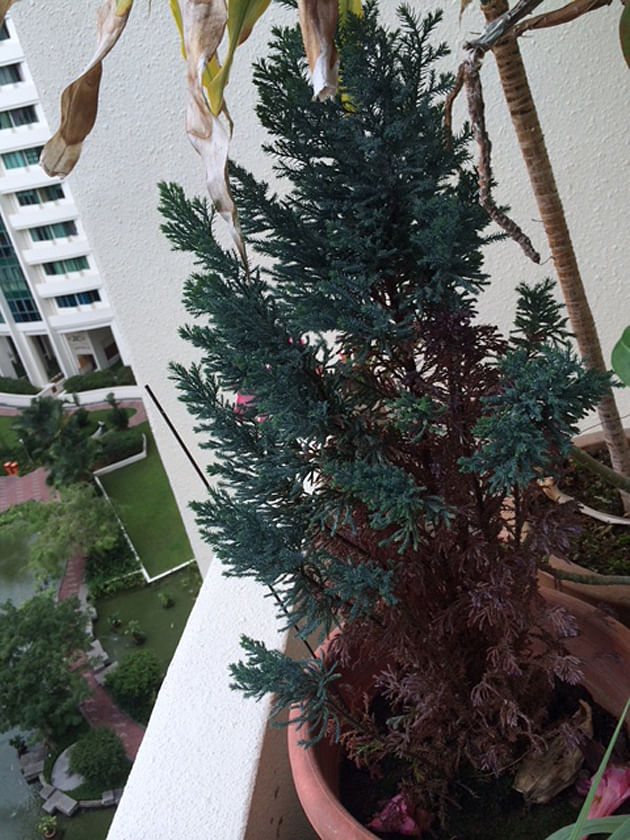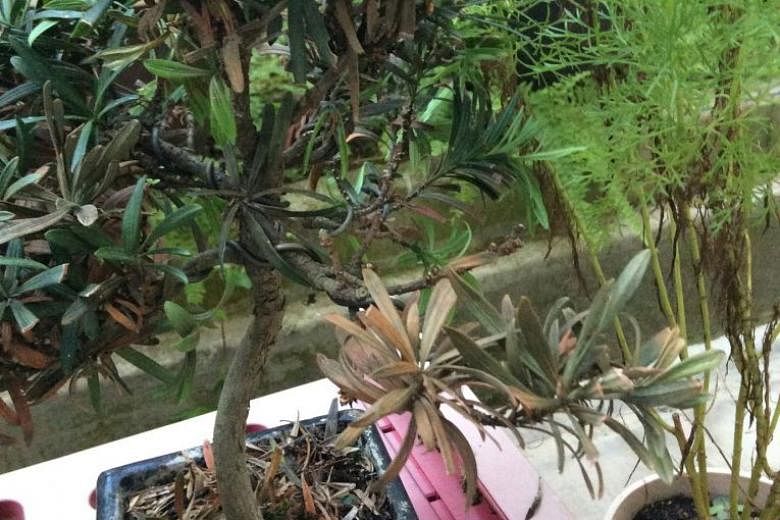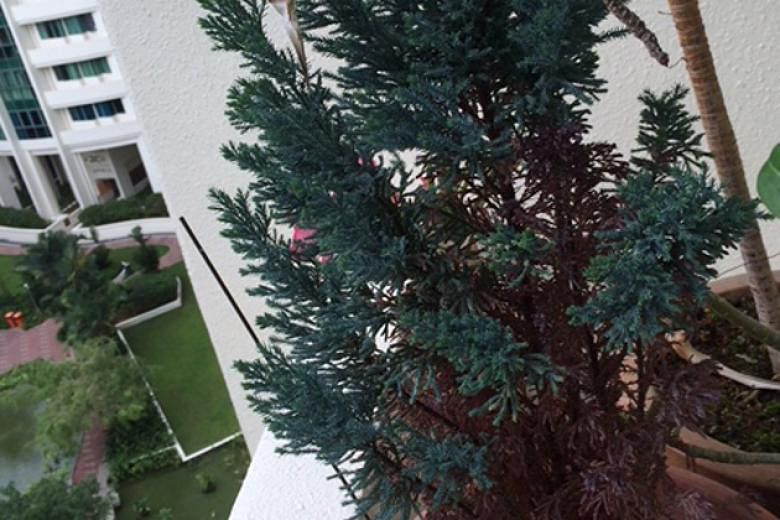Joyweed needs 6 hours of direct sunlight to thrive
I bought this plant from the supermarket. How do I care for it? The windows at my home are southeast- facing and get morning sun most of the time.
Daniella Yow
The plant is commonly called Joyweed or Joseph's Coat. It belongs to the genus Alternanthera and there are many cultivars with highly ornamental leaves.
This plant needs to be grown under direct sunlight for at least six hours daily to retain its vivid foliage colours and compact growth form. The lack of sufficient sunlight will lead to lanky plants with faded colours in the leaves.
It propagates easily from stemcuttings. Prune it often to encourage a bushy growth habit.

Chilli plant attacked by broad mites
The leaves on my chilli plant used to look green and healthy. However, they have started to wither when the plant is about to bloom. This occurs even when the plant gets adequate sunlight, water and fertiliser. What is wrong with it?
Serene Khoo
Your chilli plant appears to be infested with broad mites, which are common pests affecting chilli plants. These sucking pests are microscopic and cannot be seen by the naked eye.
The most effective means of pest control is via the application of sulphur soap solution on the affected parts. But do note that affected leaves will not recover.
The sulphur soap solution is made by grating a sulphur soap bar and dissolving a teaspoon of soap flakes in a small amount of hot water.
This is then topped up to 1 litre with tap water to make a diluted sulphur soap solution.
Spray the solution on the leaves of the plant. Repeat applications are often necessary to keep the pest population in check.
If the pests have been successfully managed, the leaves will appear healthy.

Buddhist pine may be lacking water
I have had this plant for almost a year. It is grown outdoors and gets a few hours of morning sun. Recently, one of its branches dried up. Other branches are displaying similar symptoms. What is wrong with the plant?
Tan Bee Ping
The plant is most likely to be the Buddhist pine, which is also known as the big-leaved podocarpus and Japanese yew. Its botanical name is Podocarpus macrophyllus and it is a common candidate for training into a bonsai.
It is a sun-loving plant and hence would require at least six hours of direct sunlight to thrive. Ensure all parts of the plant are given sunlight exposure - you can do so by rotating the plant regularly.
Also, do not crowd plants around the bonsai as they can cast shade on it. If a certain part of the plant is not receiving sufficient sunlight, it is not unusual for dieback to occur.
Another reason for the dyingback of the branch could be a lack of water or an issue with the roots.
As the bonsai is constrained in a small pot, it needs to be watered regularly. The drying out of the root zone can cause dying-back of growth.
Check the health of the roots as it can affect the plant's uptake of water.
Finally, check if the branch has a pest attacking it. Minute sucking pests such as spider mites, in severe cases, can cause leaves to dry and fall away.
Chuan Lian plant has medicinal properties
My neighbour gave me a plant and told me that the juice from the leaves has healing properties for the eyes. What is the botanical name of the plant?
Benny Foo
The plant is botanically known as Senecio ampliflorus. Its local Chinese name is Chuan Lian. It is a plant that is commonly grown for its medicinal uses.
However, as with many medicinal plants, its healing properties have not been systemically studied in humans and proven by science. It is best to proceed with caution and consult a doctor for illnesses.
Nevertheless, its silvery-green leaves make it an attractive foliage plant. Grow it under semi-shaded conditions and do not overwater as the plant tends to rot easily when the soil is soggy.

Lawson cypress often used as Christmas decoration
This plant has turned brown at the bottom. How do I make it green again?
Au K.W.
The plant is commonly known as the Port Orford cedar or Lawson cypress. Its botanical name is Chamaecyparis lawsoniana.
It is often imported here during the Christmas season for use as a miniature decorative Christmas tree for table-tops and dish gardens.
This plant comes from a temperate climate and does not do well in the long term in the lowland wet tropics in Singapore. You need to ensure it gets sufficient sunlight and allow the roots to dry out periodically before watering again. You may also need to protect it from rain.
A soggy root zone will bring about disease and cause the interior of the plant to die, as seen in the picture.
• Answers by Dr Wilson Wong, an NParks-certified practising horticulturist and park manager. He is the founder of Green Culture Singapore and an adjunct assistant professor (Food Science & Technology) at the National University of Singapore.
• Have a gardening query? E-mail it with clear, high-resolution pictures of at least 1MB, if any, and your full name to stlife@sph.com.sg





